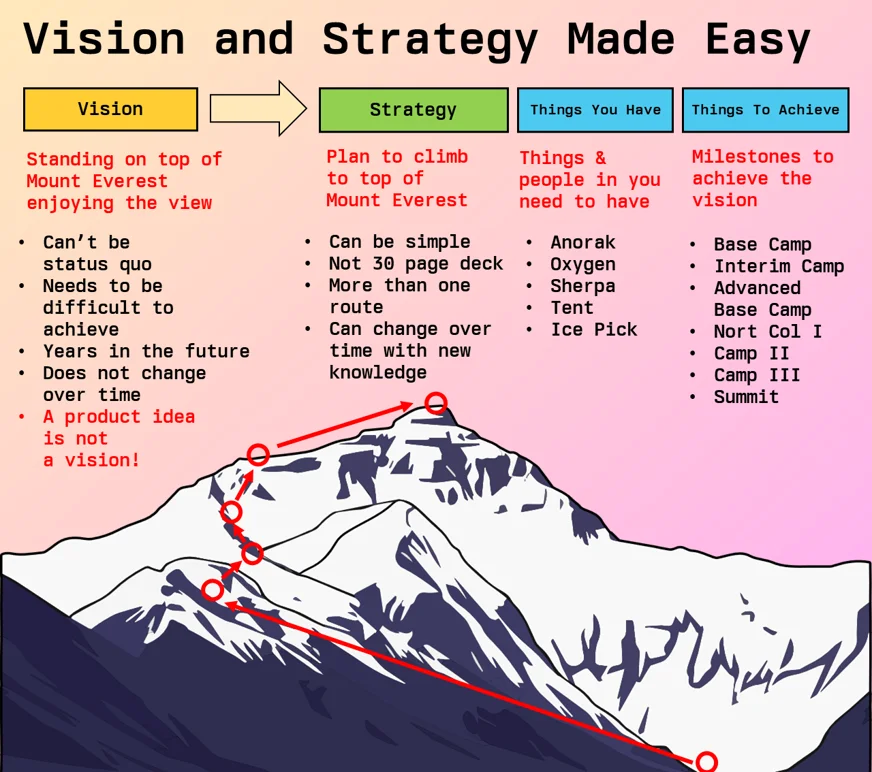Stephan Schmidt - September 25, 2025
Vision and Strategy Made Easy
A hands-on guide for CTOs and founders to craft clear, actionable vision and strategy
TL;DR: Vision and strategy don't need to be complex 30-page decks—they should be simple, plausible plans that fit on a napkin and help everyone make the right decisions at critical junctures. For CTOs specifically, derive your tech vision from the business strategy (not the company vision), focusing outward on how technology enables business success, then outline the key capabilities, people, and milestones needed to get there.
Most founders, CEOs and CTOs have no vision or strategy. At most they have a product idea and beyond the initial launch are A/B or opportunity driven. Or they have a vision in some slides from an old strategy workshop that no one ever looked into again. That is full of buzzwords and corporate speak so no one remembers it.
What to do instead?
A vision and strategy are tools, not things to be put in a frame on the wall. A vision and strategy help everyone in the organization to make the right decisions and to focus on greatness. Coming to a fork in the road, should I go left or right? A vision and strategy guide that decision.
People fear vision and strategy. “I’m not a visionary!” is what I hear often. “I can’t do strategy, I’m not a strategy consultant!” or “Strategy is too much work!” and they have other things to do.
People think strategy is a strategy paper. Or a 30-page deck. Or something that happens once a year in a strategy offsite.
Strategy is simple. And you get better by doing it.
Lets start with a vision. A vision is where you want to be in the future. Where you are happy. A place that is self-explanatory and self-motivating.
The strategy is your plan to achieve your vision. That strategy can be a very short plan. It can fit on a restaurant napkin. It does not need to be a 30-page deck. A strategy is a plausible plan to achieve your vision - not more and not less. It has things that you need to have and milestones that you need to achieve.
An example.
Your vision is to bring people to the top of Mount Everest opening their minds. Your vision is not about you, but about others. It’s not about your product, it’s how you change the world and life of people. A vision is outward looking. This goes for both the business and tech visions.
Your strategy is how to get there. The things & people you need to have and the milestones you need to achieve.

To bring people to the top of Mount Everest,
you might need:
- Anorak jackets
- Guides
- Ice picks
- Tents
- Oxygen
and milestones to achieve:
- Arrive at Mount Everest
- Base camp
- Interim camp
- Advanced base camp
- North Col I
- Camp II
- Camp III
- Summit
This plan sounds plausible. Your strategy does not need to be correct, because you can’t look into the future. But it needs to be plausible. And as an exercise you can try to find wholes in your strategy and fill the gaps in your knowledge. But it doesn’t need to be correct: Assuming you want to go by truck from A to B, there are 3 milestones: bridges 1, 2 and 3. When you reach bridge 2, you find out that you can’t cross it with an 18-wheeler, because there is a construction going on. So you adapt your plan and wait for the construction to end, look out for another bridge or get two smaller trucks to cross the bridge. You adapt your strategy when new knowledge arises or circumstances change. You’re not chaning your vision to go to B.
There is more than one strategy to achieve your vision. If there is only one strategy, your vision might be not big enough. There is more than one route to the top of Mount Everest. And you can go with oxygen or without oxygen.
Vision and Strategy for CTOs
You derive your tech vision from your business strategy. Your vision is not about yourself, but outward, how you help the business strategy to succeed. This is an important point, where I see many mistakes being made.
If the business vision is to bring people to the top of Mount Everest, your vision needs to be how and what anorak jackets you provide. Or how you are able to provide the best effort. Or how you help business determine the best route to the top. Your vision is not determined by the company vision, otherwise you would build another company. Your vision is determined by business strategy.
The business vision could be to connect people with their ancestors. And the business strategy would be to build a system where people can add stories about themselves and an AI avatar their children can talk to.
What are the key achievements and critical points in the business strategy related to technology?
Your tech vision would now be something like “To achieve an authentic presence by creating a generative model of an individual’s unique worldview.”
About me: Hey, I'm Stephan, I help CTOs with Coaching, with 40+ years of software development and 25+ years of engineering management experience. I've coached and mentored 80+ CTOs and founders. I've founded 3 startups. 1 nice exit. I help CTOs and engineering leaders grow, scale their teams, gain clarity, lead with confidence and navigate the challenges of fast-growing companies.

Related Articles
Transparent communication and predictable actions framework
Managing joy-driven versus discipline-driven developers
Using technical innovation to drive product success
Why roadmaps create deadline pressure and corner-cutting
Developing intentional engineering culture to reduce micromanagement